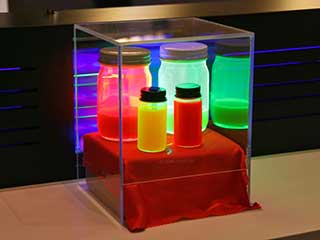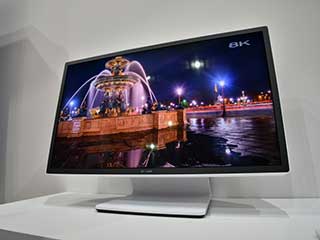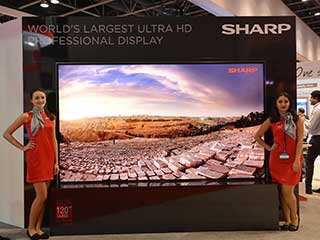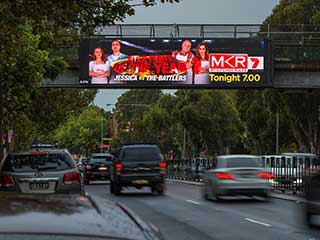LCD Displays and LED Screens: Modern Technology
LCD displays are firmly established in the advertising market niche and are almost on the brink of 4К UHD resolution. The evolution of LCD was so fast; we frequently could not keep up with it. Let us consider the current technological status of LCD displays and LED screens of high resolution. What is looming ahead?
Quantum Dots and IGZO
One of the key elements in Liquid Crystal technology is backlight. Everything started with CCFL lamps (fluorescent lamps with cold cathode). Later this light source was changed to LEDs. LEDs have many advantages: lower energy consumption, uniform and targeted backlight, lower thermal signature of LCD displays. An important factor is also the ecological advantage of the LED backlight.
 |
 |
| 3M Quantum Dots Demo | IGZO LCD Display 8К 7680×4320 Pixels by Sharp |
However modern LCD backlight is not without drawbacks. To ensure quality backlight it is necessary to provide accurate color filters and wide band white backlight. However modern white LEDs are characterized by a narrow radiation band. Therefore, the Quantum Dot (QD) technology came to replace the standard white backlight.
Instead of white LEDs with filters, a film with red, blue and green quantum dots is used. These dots under light radiate pure colors of very narrow band. QD technology needs no color filters using high quality light source. OLED displays are at the early stage of their development and are not yet in great demand due to some drawbacks and high cost. The QD method allows to improve quality of LCD displays without increasing their price. It is quite possible that we will soon witness the appearance of a QD QLED display that will restore the time of high quality CRT monitors with high-response and excellent color rendering.
Another new technology IGZO is developed by Sharp. IGZO (Indium-Gallium-Zinc-Oxide) is a semiconductor material at the center of LCD display. Each pixel of an LCD panel is controlled by a transistor. IGZO transistors have certain advantages compared to amorphous silicon. Essentially, IGZO transistors are significantly smaller in size which is very important for displays of very high resolution. The fact that IGZO technology may be equally useful for LCD and OLED displays is an additional advantage.
Traditional LCD Displays
 Sharp 120” 4K2K Ultra HD Display
Sharp 120” 4K2K Ultra HD DisplayIn the past several years LCD displays managed to pass the stage of 4K UHD resolution. Technically, the resolution of ultra high quality is a by-product of 4K film standard. However, the 4K resolution is a native format of 4096x2160 pixels, while the new Ultra HD is a commercial standard with somewhat lower resolution 3840x2160 pixels.
Samsung and LG recently introduced LCD displays with the 21:9 aspect ratio (they are frequently called “Ultra Wide”). These same models can be seen in a curved variant. The size of these LCD displays reached 105”. We are used to 40” and 80” LCD displays, but their next generation of commercial large 4K displays with 110”-120” size are soon to follow. And finally we have to discuss the bezel thickness. LG recently announced new 48” and 54” LCD displays with an amazing bezel thickness of 1/16 inch (or 1.8 mm). This allows to create practically seamless video walls.
Another technology SoC (System-on-a-Chip) developed by Samsung is developing fast. Physically, SoC is a micro-computer that is embedded in the screen in the form of a chip. It can be used as a media player for digital signage or for other purposes. The major advantage is that SoC technology does not need to use external devices.
Modern Technologies of LED screens
Outdoor LED Screens
 APN Outdoor LED Screen with Pixel Pitch 6.67 mm in Sydney
APN Outdoor LED Screen with Pixel Pitch 6.67 mm in SydneyTechnological improvements (higher frame frequency and color depth) can be utilized for the purposes of public places in the immediate proximity to the audience. In the past years the most popular among customers were 10 mm pixel pitch SMD LED screens, but at the same time the tendency towards smaller pixel pitch (8, 6 and even 4 mm) on outdoor screens is on the rise.
Outdoor LED screens with high resolution are ideal for advertising. Already the market is quite satisfied with the performance of LED screens. They are mature, have long life and long mean time between failures (MTBF). The improvements will continue but even the current status is quite satisfactory.
Indoor LED Screens
Today the pixel pitch on Direct View LED screens may reach 1 mm. It is difficult to single out any one company. Samsung, SiliconCore, Daktronics, Christie, Leyard, NanoLumens, Panasonic, Mitsubishi and even NEC – this is an incomplete list of companies who accomplished this brilliant breakthrough. Possible the term Direct View is misleading to denote displays with extra small pixel pitch. As if one could not watch the LED screens directly before! Most probably this term appeared because at pixel pitch 1.5 mm and smaller it becomes possible to look at the LED screen from a distance of an extended hand.
It is now a fact that the SMD LED technology with millimeter and submillimeter pitch is at its technological limit (see LED module photo). Today LED screens are indisputable winners in the outdoor advertising industry. This situation will last for a few more years, unless there new advances in the OLED technology and the new and promising QD displays.





